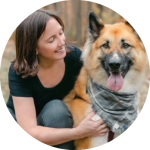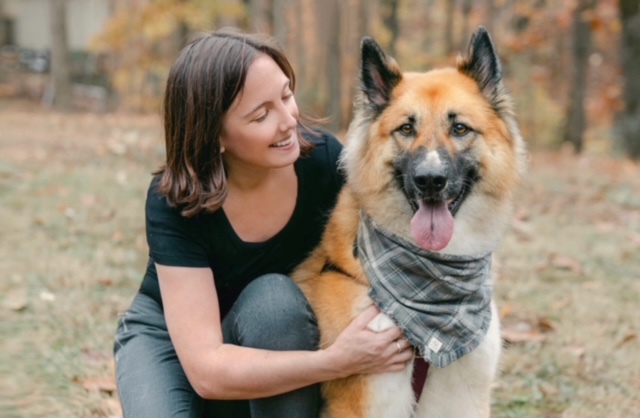Reactive Dogs by Frankie Jackson, CCPDT Certified Professional Dog Trainer & owner of Canine Counseling. Imagine the scene. It’s a beautiful day, you’re strolling through the park and spot a sweet little Goldendoodle racing around. Suddenly she spots another dog, this one is on-leash, and races towards them to say hello. “It’s ok, she’s friendly!”, the owner of the Doodle yells, laughing as their errant pup ignores their attempts to call them back. To many dog owners this may sound far from worrisome but for those among us with reactive dogs the same scenario could be a potential nightmare.
Hi, my name is Frankie Jackson and I’m a Certified Canine Behavior Consultant. Having worked with dogs professionally for over 15 years, I can safely say that reactivity is by far the most common issue I see in adult dogs regardless of their sex, size, neuter status or breed. Unfortunately many people see these dogs as aggressive, dangerous or frightening when the vast majority of them are simply terrified.
Treating reactive dogs requires their caretaker to be patient, consistent and willing to practice their training regularly, often with the help of an expert. Unfortunately even the best dog trainer can’t control the behavior of other dogs or their owners meaning potentially dangerous situations, like going head-to-head with an off-leash Doodle, are still possible. An encounter like this could, at best, cause our reactive dog to regress or, at worst, result in serious (or even fatal) injury to the other dog.
Instead of focusing on treating the reactive dog I’d like to pose this question: How can we be better allies to reactive dogs and their owners? First, it’s important to understand the reasons these pups are reactive in the first place and what their ‘fearsome’ behavior really means.
Dogs have complex emotions and, just like us, have different ways of showing them. With fear and anxiety, the most common root causes of reactivity, we can lump most of our dog’s possible responses into four categories. Simplified, I label these categories as confrontation, avoidance, suppression and reconciliation. Though labeled in many different ways you might know these same behaviors by their more common names: Fight, flight, freeze and fawn. If you were a fan of biology as a kid you might recall that these actions are responses to our sympathetic nervous system, a network of nerves that activates when we experience stress, fear or danger. Dogs have the exact same system, so let’s delve into each one.
The first on the list is confrontation; the fight response. Let’s save this one for last (you’ll see why later).

Did you find this article useful? Would you like 100% free access to more articles like these, and free access to over 5,000 vetted pet care service professionals throughout the United States? Sign up here for a free Petworks account, and take 10% off your first booking, on us!
The Flight Response
Next we have avoidance; the flight response. Simply put, this reaction aims to get us as far away from whatever danger we are facing as possible, as soon as possible. This could be outrunning, hiding from or otherwise evading the thing that frightens us.
Let’s look at some human examples:
• You spot a coworker you dislike in a store and duck down the aisle to avoid speaking to them.
• A young child is scared of thunder and hides in their closet to feel safe.
• You get chased by a wasp and quickly run in the opposite direction to avoid being stung. In each scenario we choose to avoid the perceived ‘danger’ in order to alleviate our feeling of stress, fear or anxiety. Similarly, a fearful dog may choose to run away from a dog approaching them, or hide under a bench from an approaching vet.
The Freeze Response
Next we have suppression; the freeze response. Freezing can help us if we either can’t or don’t want to completely avoid the danger, but don’t wish to actively approach it.
Once again, let’s look at some examples:
• You spot a spider from across the room and believe that if you move it’ll run away. You stand perfectly still and scan the room for something to catch it with.
• You hear a strange noise in your empty house and sit quietly, listening out for further sounds.
• You spot the same co-worker but this time have nowhere to hide, so you put your headphones in and watch them until they are out of sight.
Instead of escaping you choose to remain where you are and actively gather more information about the situation without sharing any of your own. If a dog approaches another dog and they aren’t sure about them they may choose to sit perfectly still and observe them, tucking their tail to prevent the other dog from discovering their scent (and therefore their personal information).
The Fawn Response
Lastly we have reconciliation; the fawn response. This response aims to befriend, soothe or appease whatever is scaring, stressing or worrying us. You may be practicing your fawn response if:
• Your partner comes home from work in a bad mood. You comfort them and encourage them to talk about their day.
• You hear a baby crying and start cooing at them in a calming voice.
• A customer is complaining at work and starts to become aggressive. You attempt to calm them down by apologizing and trying to rectify the situation
Fawning aims to openly share information with our threat, encouraging them to communicate with you in order to resolve any conflict. Dogs display these behaviors very differently from us and we may see things like rolling over, face-licking, urinating and loose and wiggly body movements. They are trying to say ‘I’m not scary, let’s be friends!’.
The Fight Response
Now comes confrontation; the fight response. The reason I wanted to save this response for last is because dogs tend to do the very same, only using it when all other options seem to have failed. Consider the following scenario:
A young child has a pathological fear of spiders. His older sister calls from another room, asking where he is and saying she has a surprise for him. The boy correctly assumes that she is about to play a prank on him, so he stays in his room, saying nothing (freeze). She finds him in his room and approaches him, holding out her closed fist and claiming there is a spider inside. The boy then attempts to plead with his sibling, telling her he’s scared and to please be nice to him (reconciliation). The sister continues to approach him, at which point he runs to the other side of the room and hides in his closet (avoidance). She chases him and sticks her hand right up to his face at which point the boy, having exhausted all his options, lashes out verbally and physically, shouting “STOP IT!” and shoving her away from him (fight).
Would you consider the little boy aggressive? Violent? Dangerous? Out-of-control? I should hope not! The exact same applies to our dogs who, in many cases, believe that they’ve exhausted all of their options. To demonstrate this I’ll use an example from my own experience.
My interest in reactive dogs came from owning one myself, Rook, a 90 lb. German Shepherd, Malamute, Husky and Akita mix. Rook is, for the most part, a sweetheart but is fiercely reactive towards unfamiliar dogs, but he hasn’t always been this way. When he was younger he was a very playful, sociable and friendly boy who was happy to approach and befriend any dog he met. Unfortunately we encountered an off-leash stray on one of our walks who attacked Rook, leaving lasting emotional damage.
 The next time Rook met an unfamiliar dog he rolled on his back, allowing the new dog to sniff him while licking the other dog’s mouth, desperately trying to make friends. This worked for the next few dogs he met but sure enough we eventually came across another unfriendly dog on our morning stroll. Rook displayed the same fawning behavior but this dog immediately lunged at him and grabbed his neck. Luckily we escaped with minor injuries but Rook was mentally shaken. He started to freeze when he saw other dogs, shying away or hiding behind my legs. He couldn’t flee, he was on a leash, so we started changing our route and walking late at night to avoid other dogs until one fateful day when we encountered, you guessed it, a friendly, off-leash Goldendoodle.
The next time Rook met an unfamiliar dog he rolled on his back, allowing the new dog to sniff him while licking the other dog’s mouth, desperately trying to make friends. This worked for the next few dogs he met but sure enough we eventually came across another unfriendly dog on our morning stroll. Rook displayed the same fawning behavior but this dog immediately lunged at him and grabbed his neck. Luckily we escaped with minor injuries but Rook was mentally shaken. He started to freeze when he saw other dogs, shying away or hiding behind my legs. He couldn’t flee, he was on a leash, so we started changing our route and walking late at night to avoid other dogs until one fateful day when we encountered, you guessed it, a friendly, off-leash Goldendoodle.
“It’s ok, she’s friendly!” shouted the owner.
I didn’t have time to shout anything back, I couldn’t get us to safety, the Doodle clearly wasn’t reading Rook’s frozen body posture and before long he was on top of us. Rook, who now realized that neither fawning, nor freezing, nor fleeing were available to either of us, chose the only option he thought he had. He fought.
 So my question remains; how do we become better allies to reactive dogs? We can understand them as fearful, anxious and stressed. Appreciate that their actions are often a last straw when all others have failed them. We realize that our dogs may trigger them and cause emotional and physical harm to both dogs and their owners. We can call away and leash our dogs, cross the road, look out for signals like yellow leashes or muzzles and most importantly, we can practice a little more kindness towards them and their owners who are just trying to help their dogs cope in a world full of challenges.
So my question remains; how do we become better allies to reactive dogs? We can understand them as fearful, anxious and stressed. Appreciate that their actions are often a last straw when all others have failed them. We realize that our dogs may trigger them and cause emotional and physical harm to both dogs and their owners. We can call away and leash our dogs, cross the road, look out for signals like yellow leashes or muzzles and most importantly, we can practice a little more kindness towards them and their owners who are just trying to help their dogs cope in a world full of challenges.
About the Author
 Frankie, owner and head trainer of Canine Counseling, is a CCPDT-certified Behavior Consultant (one of only 8 in Georgia!) and worked for 13 years as a registered veterinary nurse in England before moving to Atlanta and becoming a full-time dog trainer. She offers basic obedience training for pups of all ages as well as assessing, diagnosing and treating problem behavior such as reactivity, guarding and extreme anxiety. She will never use force, fear or pain to train your pup.
Frankie, owner and head trainer of Canine Counseling, is a CCPDT-certified Behavior Consultant (one of only 8 in Georgia!) and worked for 13 years as a registered veterinary nurse in England before moving to Atlanta and becoming a full-time dog trainer. She offers basic obedience training for pups of all ages as well as assessing, diagnosing and treating problem behavior such as reactivity, guarding and extreme anxiety. She will never use force, fear or pain to train your pup.


